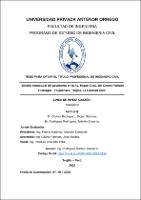Diseño estructural del pavimento en la Av. Miguel Grau, del Centro Poblado El Milagro – Huanchaco, Trujillo, La Libertad 2022

View/
Download
(application/pdf: 141.9Kb)
(application/pdf: 141.9Kb)
Date
2023Author(s)
Gómez Rodríguez, Jhojan Sleymar
Rodríguez Rodríguez, Julinhio Eduardo
Metadata
Show full item recordAbstract
La siguiente investigación trato obtener un diseño óptimo para la Av. Miguel Grau
ya que se encuentra desgastada y sin mejoramientos. Se realizaron trabajos de
gabinete como trabajo de campo en la cual se ve en nuestros resultados todo que
hemos ido investigando.
Se realizó un conteo de vehículos para saber la carga vehicular diaria y mensual y
así poder determinar su IMDA y hacer un diseño que nos permita evitar tener fallas
a largo plazo.
En el conteo de vehículos se vio reflejado que hora con mayor transitabilidad es a
las 7 am, 12pm a 2pm, 5:30pm a 7pm; en la cual se debió proponer mayo
señalización para evitar aglomeraciones y la carga vehicular no esté tan elevada.
Para determinar los espesores de los tipos de pavimento se realizó varios ensayos
en la cual nos dio que un pavimento flexible tiene una sub base de 0.20 m, base de
0.15 m y carpeta de rodadura de 0.05 m; en diferencia que un pavimento rígido nos
dio una sub base de 0.20 m, una base de 0.15 m y una losa de concreto de 0.15 m
y finalmente para un pavimento articulado nos dio una sub base de 0.20 m, base
de 0.15 m, cama de arena de 0.05 m y el adoquín de 0.08 m.
Por otro lado, se realizó los costos unitarios por cada tipo de pavimento en la cual
se vio reflejado por el costo x m2 y se decidió por un pavimento flexible ya que era
el que más se adecuaba a un presupuesto base The following investigation tried to obtain an optimal design for Miguel Grau Avenue
since it is worn out and without improvements. We carried out cabinet work as field
work in which our results show everything that we have been investigating.
A vehicle count was carried out to determine the daily and monthly vehicle load and
thus be able to determine the IMDA and make a design that will allow us to avoid
failures in the long term.
The vehicle count showed that the busiest hours were 7 am, 12 pm to 2 pm, 5:30
pm to 7 pm, and 5:30 pm to 7 pm, when signage should have been proposed in
order to avoid crowds and to reduce the vehicle load.
To determine the thicknesses of the types of pavement, several tests were carried
out, in which we found that a flexible pavement has a sub base of 0.20 m, a base of
0.15 m and a wearing course of 0. 05 m; whereas a rigid pavement gave us a sub
base of 0.20 m, a base of 0.15 m and a concrete slab of 0.15 m and finally for an
articulated pavement it gave us a sub base of 0.20 m, a base of 0.15 m, a sand bed
of 0.05 m and a cobblestone of 0.08 m.
On the other hand, the unit costs for each type of pavement were made and reflected
by the cost x m2 and it was decided to use a flexible pavement since it was the most
suitable for a base budget
Collections
- Ingeniería Civil [1260]

